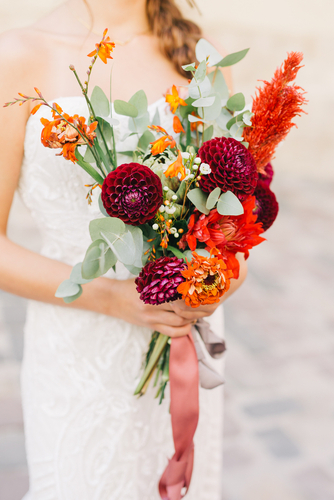How To Use the Elements of Floral Design To Select Wedding Flowers

Picking the right floral arrangements for your big day is about a lot more than pointing to some blossoms you think look pretty and calling it a day. Flowers comprise a large chunk of the visual decor featured during a wedding reception. If you don’t think about them, you could end up with an event that looks drab, awkward, or gauche. One excellent way to avoid this is by making your selection based on the basic elements of floral design. Use these tips to make a decision that brings your nuptials to life.
Form and Shape
Though hearing the word “flower” might conjure up specific images, all plants are unique when it comes to physical characteristics. Lilies look different from roses, which look different from daisies, and so on. One way to narrow your search is by thinking over the form and shape of the individual petals and florets. Reviewing how each stem appears on its own can offer a bit of insight into how your bouquets and centerpieces will come together should you pick this particular flower.
Color
Next, it is time to move into familiar territory. Most people pick floral arrangements based on color to begin with, so factoring this into your final decision shouldn’t be difficult. However, try to think about color from an overall design perspective rather than your own personal preferences. Knowing which shades complement each other, for example, can make picking the best blossoms a much less challenging experience. Working with a florist or designer can be incredibly useful when you don’t know much about color to begin with.
Patterns and Textures
Beyond color, flowers are unique in that many petals boast interesting patterns and textures. Though these patterns serve a specific purpose of guiding bees and other pollinators to the right spots, human beings tend to appreciate these qualities on an aesthetic level. Similarly, when blossoms feature a unique texture, guests who lean in for a closer look will be surprised by the intricate natural beauty of each petal.
Floral Design Size
Just as flowers all boast different patterns, shapes, and colors, so does each species come in a variety of sizes. When picking blossoms for your wedding bouquets, size should be considered. Specifically, you want to play around with this element as much as possible. Having flowers that are all exactly the same size in an arrangement will look weird, so mix things up by including big and small flowers alongside the mid-sized options. From the large yellow petals of the sunflower to the small wisps of baby’s breath, there’s quite the range to play with.
Scent
Finally, don’t forget that flowers offer more than visual appeal. The fragrance provided by some blossoms can be truly intoxicating, so be sure to gain some information on this front. While there are plenty of aromatic options, some are also less pleasant. Grouping too many pungent flowers together can be more than enough to overwhelm your guests. Learning about how to balance the fragrances can be a wonderful way to play around with more than one sense with your arrangements.
Final Considerations For Your Floral Design
Using the basic elements of floral design to guide your decision can be useful because doing so allows you room to look at your bouquets from a few different perspectives. While color tends to be the main feature people notice when gazing at blossoms, it is far from the only point that couples should review. Looking at examples of arrangements online is an excellent way to see just how many ways you can go with your bouquets.
Though flowers might come in all shapes and sizes, there’s no need to feel overwhelmed when picking the right buds for your nuptials. Educate yourself on a few main points and work with a florist to find the perfect fit.














